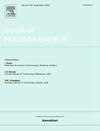Numerical simulation of flow and heat transfer characteristics of liquid lithium metal inside trapezoid shaped wire rod bundle channels
IF 2.3
3区 工程技术
Q1 NUCLEAR SCIENCE & TECHNOLOGY
引用次数: 0
Abstract
The advancement of compact reactor technology, including the development of small and liquid metal reactors, has led to a surge of interest in the concept of wire-wound core arrangements for achieving enhanced compactness. The installation of trapezoid shaped wires permits the fuel rods to support themselves, facilitates the heat transfer through the channels, and allows for a compact configuration. However, the presence of wires introduces a degree of complexity to the flow and heat transfer process, prompting to investigate the thermo-hydraulic properties of fuel rod bundles with wires. This paper presents a numerical analysis model of a fuel rod bundle channel with trapezoid shaped wires in a hexagonal arrangement, with the objective of investigating the influence of trapezoid shaped wires on the flow and heat transfer characteristics. The results indicate the presence of transverse flow within the channel. The transverse velocity at the near-wall surface of the fuel rod is in alignment with the twisting direction of trapezoid shaped wires, whereas at the top of the wires, it is in opposition to this direction. The center rod and the corner rod exhibit low temperatures and high convective heat transfer coefficients at the trapezoidal winding wire. The transverse and axial velocities demonstrate periodic fluctuations with a period of approximately H/4, and a comparable pattern is evident in the fluctuations of the hot spot factor (FHS) and Nusselt number (Nu). It is observed that frictional resistance coefficient (f) and convective heat transfer coefficient (h) of trapezoid shaped wire rod bundle channels are higher than those of classical round rod bundle channels. The pertinent research findings furnish a theoretical foundation for the utilization of this specific fuel rod in lithium-cooled fast reactors.
梯形线束通道内液态锂金属流动与传热特性的数值模拟
紧凑型反应堆技术的进步,包括小型和液态金属反应堆的发展,引起了人们对实现增强紧凑性的线绕堆芯安排概念的兴趣激增。梯形导线的安装允许燃料棒支持自己,促进热量通过通道传递,并允许一个紧凑的配置。然而,金属丝的存在给流动和传热过程带来了一定程度的复杂性,这促使人们对带有金属丝的燃料棒束的热水力特性进行研究。本文建立了六角形布置梯形丝燃料棒束通道的数值分析模型,研究了梯形丝对燃料棒束通道流动和传热特性的影响。结果表明通道内存在横向流动。燃料棒近壁面的横向速度与梯形丝的扭转方向一致,而在梯形丝顶部的横向速度与梯形丝的扭转方向相反。中心棒和角棒在梯形绕组线上表现出低温和高对流换热系数。横向和轴向速度表现出周期波动,周期约为H/4,热点因子(FHS)和努塞尔数(Nu)的波动也表现出类似的模式。观察到梯形线束通道的摩擦阻力系数f和对流换热系数h均高于经典的圆形线束通道。相关研究结果为该燃料棒在锂冷快堆中的应用提供了理论基础。
本文章由计算机程序翻译,如有差异,请以英文原文为准。
求助全文
约1分钟内获得全文
求助全文
来源期刊

Annals of Nuclear Energy
工程技术-核科学技术
CiteScore
4.30
自引率
21.10%
发文量
632
审稿时长
7.3 months
期刊介绍:
Annals of Nuclear Energy provides an international medium for the communication of original research, ideas and developments in all areas of the field of nuclear energy science and technology. Its scope embraces nuclear fuel reserves, fuel cycles and cost, materials, processing, system and component technology (fission only), design and optimization, direct conversion of nuclear energy sources, environmental control, reactor physics, heat transfer and fluid dynamics, structural analysis, fuel management, future developments, nuclear fuel and safety, nuclear aerosol, neutron physics, computer technology (both software and hardware), risk assessment, radioactive waste disposal and reactor thermal hydraulics. Papers submitted to Annals need to demonstrate a clear link to nuclear power generation/nuclear engineering. Papers which deal with pure nuclear physics, pure health physics, imaging, or attenuation and shielding properties of concretes and various geological materials are not within the scope of the journal. Also, papers that deal with policy or economics are not within the scope of the journal.
 求助内容:
求助内容: 应助结果提醒方式:
应助结果提醒方式:


